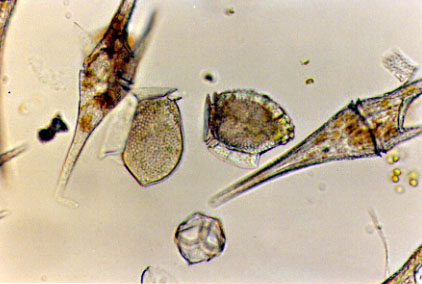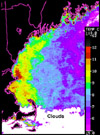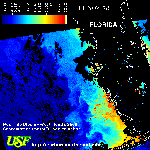

Harmful Algal Bloom Photo Gallery
All readers are invited to submit their optical creations of HAB phenomena
"visible" phytoplankton blooms
 California Noctiluca Bloom |

Florida Red Tide Bloom of Karenia brevis |

Texas Brown Tide Bloom of Aureoumbra |

Close-up of a Texas Brown Tide Bloom of Aureoumbra |

York River (Chesapeake Bay) Red Tide Bloom of Cochlodinium heterolobatum |
1999 Hong Kong Red Tide (Unidentified species) |

| 
| 
|
| 9/21/99 | 9/23/99 | 9/29/99 |
This red tide bloom followed closely after heavy rains associated with Hurricane Floyd, which ended a very dry summer. The photo on the left shows the surface slick of the bloom. The middle photo shows how the bloom appeared after wind dispersed it in the surface waters. The photo on the right depicts the same area after the bloom period was over. (All 3 photos credit - Maureen Keller, Bigelow Lab.)
 Nodularia spumigens bloom, January 2002, in the Gippsland Lakes, Victoria, Australia Photo credit: J.D. Kinnon |
photomicrographs of Harmful Algal Species
 Immunofluorescently-labeled Alexandrium cell
Immunofluorescently-labeled Alexandrium cell
Alexandrium sp. (most likely fundyense) from a bloom near Casco Bay, Maine in 1998. The Alexandrium cell (about 35µm in diameter) is the
smaller of the two cells. It shows the red autofluorescence of the chlorophyll surrounded by a bright green immunofluorescent stain that
specifically targets the cell surface antigens of Alexandrium. The other larger cell is a co-occurring heterotrophic Protoperidinium sp.
that lacks chlorophyll. (Kristin Gribble, WHOI)
 Fluorescently-labeled Alexandrium cell
Fluorescently-labeled Alexandrium cell
 Mixed bloom of Dinophysis acuta and D. norvegica co-occurring with a bloom of Ceratium furca
Mixed bloom of Dinophysis acuta and D. norvegica co-occurring with a bloom of Ceratium furca
![]()
satellite imagery during bloom events
 North Carolina Sea Surface Temperature image of a Karenia brevis bloom
North Carolina Sea Surface Temperature image of a Karenia brevis bloom
The image to the left is an AVHRR satellite infrared image depicting sea-surface temperature off the coast of North Carolina in late October, 1987. This advanced, very high resolution radiometer (AVHRR) photo shows a blue filament of Gulf Stream water (24-25°C) near Cape lookout that is now known to have transported toxic Karenia brevis cells from the Gulf Stream (deep blue), into the colder (yellow) coastal waters. The filament remained detectable in satellite images for three weeks. (T. Leming)
 Gulf of Maine Sea Surface Temperature image of an Alexandrium sp. bloom
Gulf of Maine Sea Surface Temperature image of an Alexandrium sp. bloom
Along the southern Maine, New Hampshire and Massachusetts coastlines,
Alexandrium blooms are known to be associated with a lower salinity,
warmer water mass (termed the Western Maine Coastal Current) that forms
during spring due to runoff of local rivers. Satellite-derived Sea
Surface Temperature (SST) imagery can be used to show the location of
the warmer waters of the WMCC and associated Alexandrium cells as it is
influenced by winds. (Click on the thumbnail image to the left.) Visible in the larger image is a narrow band of
deeper colder water (blue) that came to the surface adjacent to the coast and
replaced the warmer WMCC waters (yellow, orange and red) that were
transported offshore by southwesterly winds. Under these conditions
(known as upwelling), shellfish toxicity declined along the coast the
Alexandrium cells were transported offshore with the waters of the
WMCC. (NOAA Coastwatch, Bruce Keafer, WHOI)
 Florida Coastal Zone Color Scanner Image (CZCS) of a Karenia brevis bloom
Florida Coastal Zone Color Scanner Image (CZCS) of a Karenia brevis bloom
This coastal zone color scanner (CZCS) image indicates a red tide bloom
in November, 1978. The red areas south of Sarasota have chlorophyll a
concentrations of greater than 3 micrograms per liter. Water samples
confirmed the presence of K. brevis in those waters.
![]()
